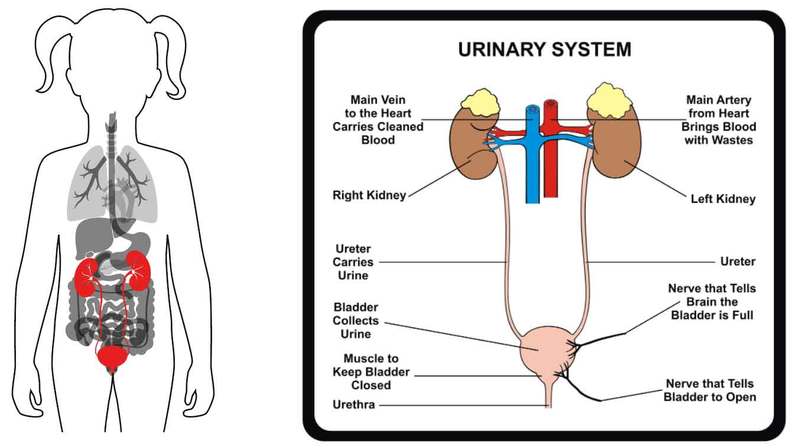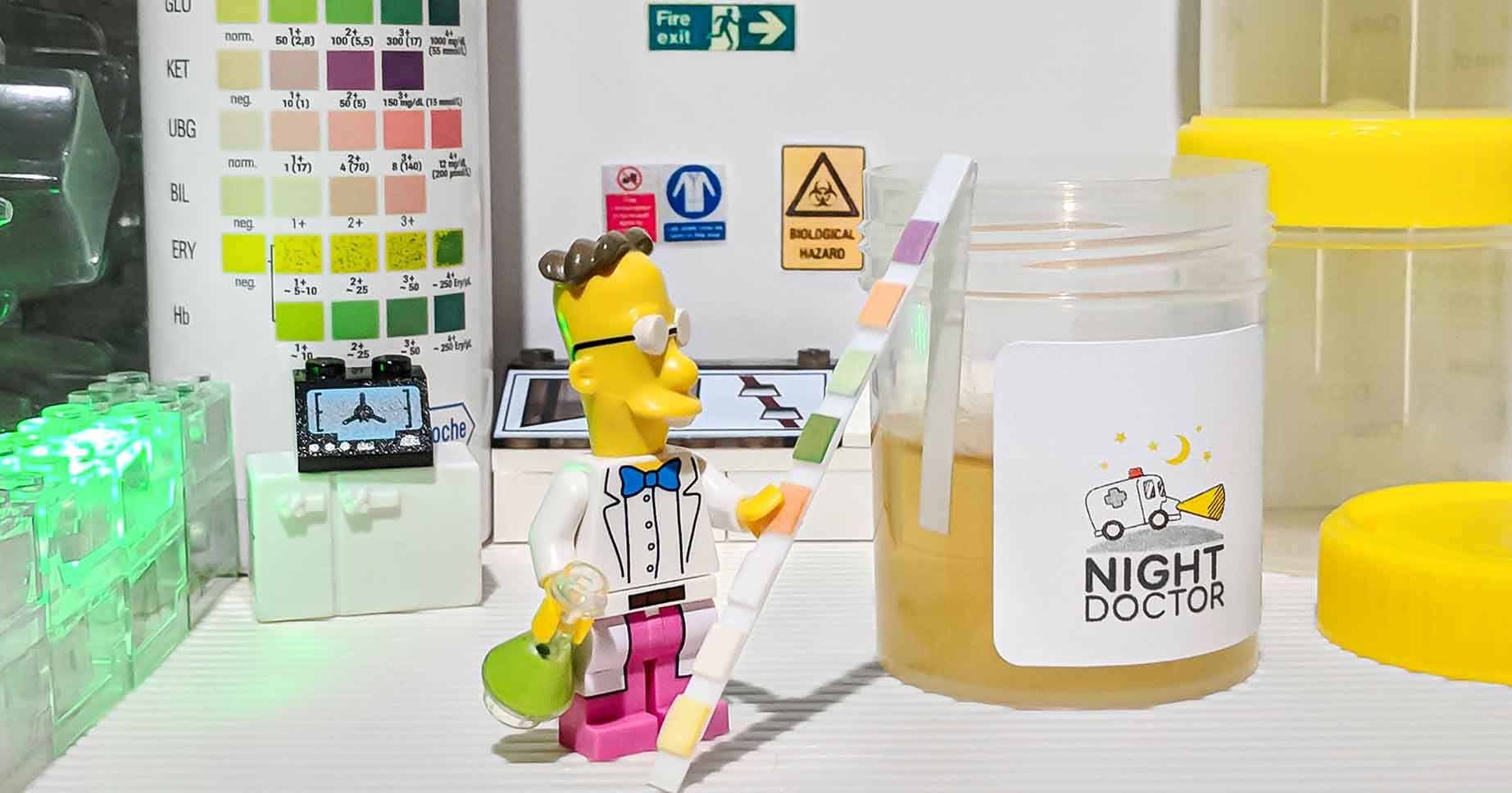Parents' guide to urinary tract infections (UTIs)
Artist: @ellieloomes
The urinary tract is made up of the kidneys, ureters, bladder, and urethra. The kidneys filter the blood and get rid of waste by making urine. The urine travels down the ureters, is stored in the bladder, and exits the body through the urethra. The urinary tract normally contains no bacteria.

What is a UTI?
When bacteria invade into the urinary tract, the urinary tract can get inflamed - we call this a urinary tract infection (UTI). People can get a lower UTI (infection in the bladder) called “cystitis”, or can get an upper UTI (infection in the kidneys) called “pyelonephritis”. It is often hard to tell in children if the infection is upper or lower1, so in this article we will talk about UTI’s in general.
How do I know if my child has a UTI?
Children with a UTI may have:1,2
- pain or burning when passing urine (going for a wee)
- a reluctance to pass urine (due to pain)
- pain in the lower part of their abdomen (tummy) or in their flank region (the side of the body between the ribs and the hips)
- feeling a need to pass urine frequently
- strong-smelling or discoloured urine
- incontinence (passing urine before getting to the toilet)
- fever
- vomiting
- lethargy (a lack of energy) or irritability
- poor feeding
When should I see a doctor?
You should seek a review from a doctor if your child develops any signs or symptoms suggestive of a UTI or if they have a fever without any clear cause.
UTIs should not go untreated as the infection can lead to damage of the kidneys, or bacteria can spread to the blood and the rest of the body and make your child very sick.3
How did my child get a UTI?
The most common way is that bacteria in faeces (poo) leaves the bowel and finds it way into the urethra. From there, the bacteria can go up into the bladder or continue to the kidneys, and establish an infection.4
Can I prevent my child getting a UTI?
There are a few things you can do at home which can help to prevent a UTI:4
Good hygiene
-
Bacteria that cause UTIs most commonly come from the bottom or poo, so it is important that when girls are wiping after they go to the toilet, they wipe front-to-back (vagina-to-bottom) so that they don’t spread bacteria to the urethra.
Avoid constipation
-
Constipation can stop the bladder from being emptied fully. Bacteria can grow well in stagnant urine, therefore ensuring the bladder is being emptied of urine fully and frequently can help prevent a UTI. If your child is constipated, please talk to your doctor.
Good toileting behaviours
-
Some children develop behaviours where they hold onto their urine or poo for too long increasing the risk of them developing a UTI. If you suspect these, talk to your doctor.
Fluid intake
-
Ensuring your child is drinking well helps prevent constipation and increases bladder emptying, reducing the risk of a UTI.
Do cranberry juice or probiotics help prevent UTIs?
Research is ongoing to understand if Cranberry Juice or Probiotics are beneficial in helping prevent UTIs in children. However, currently there is insufficient evidence to support their use.5
How do you test for a UTI?
To find out if your child has a UTI, your doctor needs to collect a urine sample and test it. There are a few different ways to collect urine. Your doctor will advise you how they want to collect the urine.
Urine collection in children who are not toilet trained
If your child is younger and not toilet-trained a common method involves waiting for them to wee into a container (called a “clean-catch urine” specimen). To do this:6
-
Have the container ready. At Night Doctor, we provide two disposable aluminium foil pie-tins stacked on top of each other. The top pie-tin acts as a lid to ensure the pie-tin underneath remains clean. The pie tin provides a large surface area in which to catch the urine.
-
Take off your baby’s nappy and clean the genital area with gauze soaked in water or baby wipes, and wash your hands.
-
When your child starts urinating (going for a wee), remove the top tin and catch the urine in the bottom tin (or in whatever container your doctor has provided). Try to catch the middle part of the urine; let you child urinate a small amount before starting to catch the urine.
-
Pour the urine from the container into a urine collection pot and then apply the lid for transfer to the laboratory. Be careful not to touch the urine or container with your skin or your child’s skin.
Urine collection in children who are toilet trained
If your child is toilet-trained, collect the middle stream of urine into a urine pot (commonly called a “mid-stream urine” specimen). To do this:7
-
Retract the labia or foreskin, and clean the area with gauze soaked in water or baby wipes
-
Keep the labia or foreskin retracted and collect the middle part of urine that comes out
-
Take care not to touch the inside of the collecting pot
What can I do to encourage my child to wee?
To help encourage your child to urinate you can:
-
give them something to drink
-
gently rub their lower tummy for a few minutes using a clean cloth or flannel soaked in cold water. Research has shown that this signicantly increases the chances of your child passing urine within a short period of time.9
Why do I need to take care when getting a sample of urine from my child?
We all have bacteria that live on our skin and if these normal bacteria get into the urine pot they can contaminate the sample. If the sample gets contaminated, we won’t know if the bacteria we found is really from the urinary tract (from an infection) or just the normal bacteria that live on the skin.
The urine at the beginning of the stream is more likely to have bacteria from the skin mixed in, which is why we like to collect the part of the urine that comes out after that (the middle part of the wee).
Should I put the urine in the fridge after I've collected it?
Ideally, you should take the urine to the laboratory straight away after collection as the fresher as sample is, the more likely it is that the laboratory can find infection on the sample. However, this is not always possible; if there is any delay to taking the sample to the laboratory, you should store it in a refrigerator (at 4°C).
Can I use a plastic stick on bag to collect the urine?
Attaching a plastic bag over the genitalia to collect a urine sample is not recommended because this method has been shown to result in contamination of the sample from the bugs that sit on the child's skin.7 At Night Doctor, we provide aluminuium pie tins instead; these are used by paediatricians as they have been shown to be at a low risk of getting contaminated.
Testing urine
A dipstick test is usually done by your doctor just after collecting the urine as this test can show immediately if there are any obvious signs of infection in the urine.
The urine is then tested in the laboratory for a more thorough test. This test attempts to identify the type of bacteria that is causing the infection, and what antibiotics are effective at killing the bacteria. Most test results are available within 48 hours.
At Night Doctor, if the doctor is able to get a urine sample from your child during the home visit, they will take the sample away with them and forward to the laboratory. They will contact you when the result is ready and also forward a report to your child's regular GP.
How do you treat a UTI?
UTIs are treated with antibiotics prescribed by a doctor. Antibiotics kill the bacteria in the urinary tract. Antibiotics are usually given by mouth, but if your child is very unwell they may need to go to hospital to get antibiotics through a drip into the vein. At Night Doctor, our doctors carry a selection of antibiotics, including a range of liquid antibiotics to start treatment in children of any age, so you will not need to visit a pharmacy to pick up the rest of the course until the next day.
How long will the antibiotics take to work
Typically your child should start to improve within 24-48 hours after starting antibiotics. If they are not improving in this time or if their condition worsens or they develop new symptoms, they should be reviewed by a doctor.2
Can I treat my child’s UTI with cranberry juice?
Although there is some evidence that cranberry juice can help treat UTIs in adults, there is no evidence to suggest that cranberry concentrate helps treat UTI symptoms in children, and is therefore not recommended.8
Should I follow-up with my GP?
It is important that your child has a follow-up appointment with their regular GP if they are started on treatment for a UTI.
A small percentage of children with UTIs will have an abnormality of their urinary tract that predisposes them to developing the infection. Therefore, your GP may organise an ultrasound scan to look for any abnormalities of the urinary tract.7 However, some GPs may wait for a second episode of a UTI before organising an ultrasound scan. It is best to discuss this with your GP.
Follow-up also allows the GP to review the child to ensure they have fully recovered from the infection.
References
- Therapeutic Guidelines, 2019. Diagnosis of UTI in children
- The Royal Children’s Hospital Melbourne, 2018. Kids Health Info: Urinary Tract Infection (UTI)
- UpToDate, 2018. Urinary tract infections in infants older than one month and young children: Acute management, imaging, and prognosis
- UpToDate, 2019. Urinary tract infections in children: Epidemiology and risk factors
- Therapeutic Guidelines, 2019. Nonantibiotic strategies to prevent UTI in children
- The Royal Children’s Hospital Melbourne, 2018. Kids Health Info: Urinary Samples
- Australian Family Physician, 2016. Paediatric urinary tract infections: Diagnosis and treatment
- Cochrane Library, 2012. Cranberries for preventing urinary tract infections
- BMJ, 2017. Faster clean catch urine collection (Quick-Wee method) from infants: randomised controlled trial
This information is general and may not apply to you or another person. If you have any concerns about your health or the health and wellbeing of a child, consult a doctor or other healthcare professional. You should never delay seeking medical advice, disregard medical advice, or discontinue medical treatment because of information on this website.
← Back to blog
